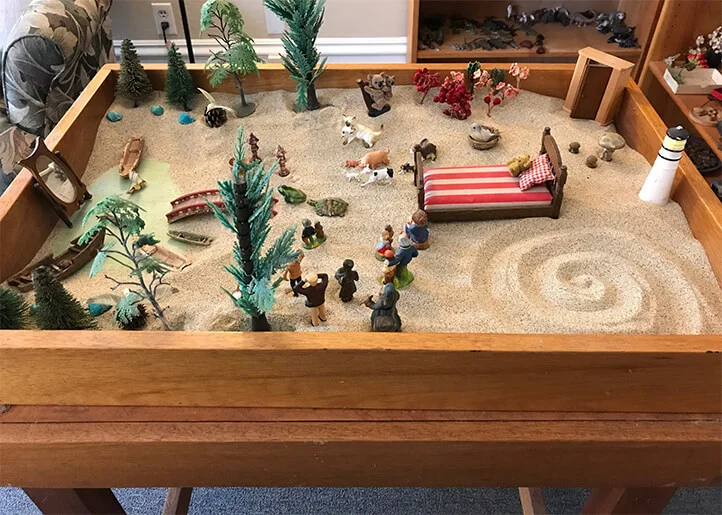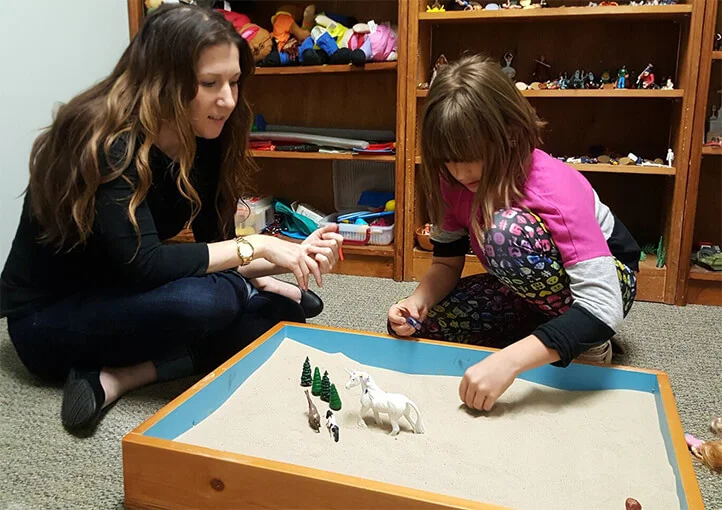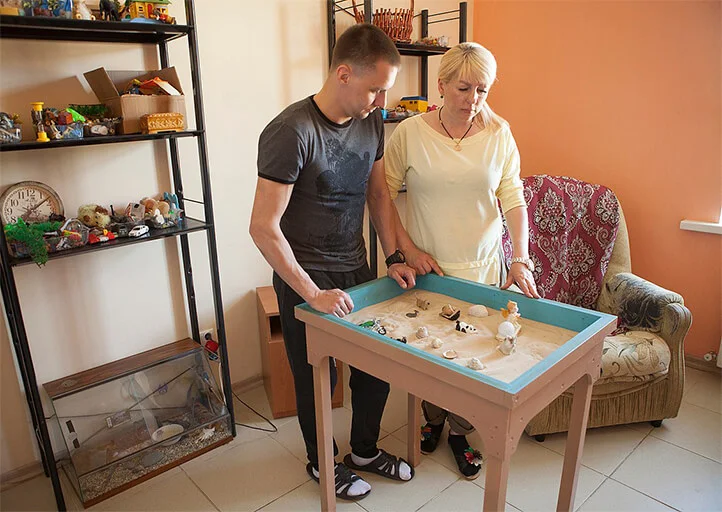Sandplay therapy is a form of art therapy where clients create scenes or images using sand, water, and miniature figures in a special tabletop sandbox. This method is used to identify and process emotions, conflicts, and issues, as well as to stimulate self-awareness and personal growth.
The use of sand and stones in meditative and spiritual practices has a long history in various cultures. For example, Japanese rock and sand gardens or Tibetan sand mandalas can be seen as predecessors of modern sandplay therapy.
The initial ideas for playing with sand were developed in the 1920s by British pediatrician and psychotherapist Margaret Lowenfeld. She used the “World Technique,” in which children created their worlds using sand, water, and toy figures. This allowed children to express their feelings and thoughts that were difficult to articulate with words.
Later, in the 1950s and 1960s, Swiss psychotherapist Dora Kalff developed and formalized sandplay therapy. She integrated her knowledge of Buddhist meditation and Tibetan medicine, along with Carl Jung’s ideas on depth psychology and archetypes.
Over time, sandplay therapy became more popular and spread worldwide, adapting to different cultures and therapeutic practices.

Sandplay Therapy: Key Principles and Methods
Sandplay therapy is a deep and multi-layered method that integrates ancient cultural practices, art therapy, and depth psychotherapeutic approaches. Its effectiveness is based on the combination of external, visible actions (creating scenes in a sandbox) and internal processes related to reflection, interpretation, and introspection.
Before delving into the details, it’s important to understand the general principles and methods underlying this practice. They determine not only the specific techniques and tools used by the therapist but also the overall approach to working with clients, creating a safe and supportive environment for exploration and healing.
Tools and Materials
Like any therapeutic method, sandplay therapy requires a certain set of tools and materials for effective sessions. These tools not only facilitate the expression of feelings and experiences but also create a space where clients can feel safe and comfortable exploring their inner worlds.
The sandbox or container where the interaction with the sand takes place is of primary importance. It is also crucial to choose the right sand, as different textures can evoke different tactile sensations and, consequently, emotional reactions. But that’s not all: a variety of miniature figures, symbols, and natural elements provide a rich arsenal for the scenarios and stories that clients create as part of their therapy.
Every element, whether a stone, figure, or even the shape and size of the sandbox, can have special meaning for the client. Therefore, selecting the right tools and materials is a prerequisite for successful sandplay therapy.
Sand Techniques
In sandplay therapy, there are several techniques that allow clients to express their feelings, thoughts, and experiences, while therapists gain a deeper understanding and interpretation of the created scenes and stories. Here are some of them:
- Free Creativity: The client is invited to work with sand without any preliminary instructions or limitations, allowing them to fully trust their inner world and intuition.
- Thematic Creativity: The therapist suggests a specific theme or plot for depiction in the sandbox, based on previous sessions or specific client issues.
- Use of Figures and Symbols: Miniature figures—animals, people, houses, trees, etc.—are used to create scenes, enabling the client to express their feelings and ideas in more detail and concretely.
- Mandala Creation: This technique is based on creating circular diagrams in the sand, helping to represent central ideas or feelings and their relationship with other elements of the client’s life.
- Work with Water: Water can be added to the sand to create different textures and effects, representing concepts such as movement, change, and purity.
- Interpretation and Discussion: After creating a scene in the sandbox, the therapist discusses with the client their choice of figures, the arrangement of elements, and the overall storyline, trying to understand and interpret the underlying feelings and thoughts.
It is important to note that in sandplay therapy, there are no strict rules or “right” or “wrong” ways to work with sand. The main focus is the process of self-expression and exploration of the inner world.
Psychological Aspects and Mechanisms of Action
Sandplay therapy is a multifunctional tool used to address a wide range of psychological issues. To understand its effectiveness, it is necessary to consider the psychological aspects and mechanisms of action behind this practice.
- Symbolic Expression: When working with sand and figures, clients can symbolically express their experiences, feelings, and conflicts, allowing them to view the problem from a different perspective.
- Regression: Sand is often associated with childhood, helping adults return to early experiences and process them in a safe environment.
- Sensory Interaction: The tactile sensations of interacting with sand are calming and also open access to deep feelings and memories.
- Control: Creating scenes in the sandbox provides clients with an opportunity to control their world, which is especially valuable for those who feel they have lost control in real life.
- Projection: Clients can project their feelings, thoughts, and fears onto the scenes they create, allowing the therapist to better understand their inner world.
- Meditative Action: Working in the sandbox acts as a meditation, helping clients to focus, cope with stress, and reflect on their problems.
- Constructive Problem Solving: Through practical modeling and recreating sand scenarios, clients can explore different approaches to solving their problems.
- Activation of the Subconscious: Working with sand stimulates subconscious thoughts and feelings, allowing them to be acknowledged and processed.
- Building Trust: Collaborative work with the therapist on the sand composition helps strengthen the trusting relationship between the client and the specialist.
- Catharsis: When clients express and discuss their feelings through sandplay therapy, emotional release may occur.

Application of Sandplay Therapy
At first glance, sandplay therapy may seem like simple entertainment with sand, but in reality, this method is a powerful tool for psychotherapeutic work. It has become a widely recognized technique in psychology and psychotherapy, allowing the exploration of deep layers of a patient’s psyche, many of which are challenging to reach through traditional methods.
This unique approach to therapy has become particularly in demand because it allows work with people of all ages, from children to the elderly, and with various psychological problems. Sandplay therapy can be used as a standalone method or in combination with other approaches to achieve maximum effect.
For Children
Working with children in the context of sandplay therapy offers a unique opportunity for a psychotherapist. Children perceive the world differently from adults, and their ways of expressing feelings and thoughts also differ. In this context, sand becomes a particularly valuable tool.
Features
-
- Symbolic Language: For children who find it difficult to express their feelings verbally, symbolic self-expression through sand offers an alternative communication channel.
- Safe Space: Creating a miniature world provides children with a safe space to explore their feelings, fears, and experiences.
- Tactile Interaction: Children actively use the sense of touch to explore the world around them. Playing with sand stimulates sensory receptors and has a calming effect.
Benefits
-
- Development of Motor Skills: Working with sand helps improve fine motor skills, which is beneficial for early child development.
- Improved Self-Expression: Children learn to express their feelings and share ideas using symbols and scenarios, which promotes communication and socialization.
- Problem Solving: Creating scenes and stories in the sandbox helps children work through complex issues or conflicts they face in daily life.
- Building Trust: Sandplay therapy helps establish and strengthen a trusting relationship between the child and the psychologist.
For Adults
Although sandplay therapy was initially developed primarily for children, it has proven effective when working with adults who come with more complex, deeply rooted problems and often with significant life experience. It provides unique methods to help adult patients on their path to self-discovery and healing.
Features
-
- Symbolic Work: Adults can use sand to create symbols and scenes that reflect their inner world, experiences, conflicts, and desires.
- Meditative State: Interaction with sand has a relaxing and meditative effect, helping adults escape from daily hustle and bustle and immerse themselves in the process of self-discovery.
- Regression: In some cases, sandplay therapy can return adults to childhood experiences, paving the way for working with long-standing psychological traumas.
Benefits
-
- Deep Self-Discovery: Through symbolic self-expression in the sandbox, adults can uncover deeply hidden aspects of their psyche.
- Safe Space: Sandplay therapy provides a safe environment to explore feelings and traumas that may be too painful or dangerous to discuss in other settings.
- Conflict Resolution: Modeling sand scenes helps adults visualize and work through personal, interpersonal, or professional conflicts.
- Creative Release: Sandplay therapy can serve as a channel for creativity, helping adults express themselves and find new ways to solve problems.
Application in Psychotherapy
- Traumatic Events: Sandplay therapy helps people process traumatic memories by providing a safe space to express their feelings.
- Anxiety Disorders: Through sandplay therapy, patients can visualize their anxiety-inducing moments and then seek ways to cope with them in a controlled environment.
- Depression: By symbolically depicting their feelings in the sandbox, patients recognize and work through their deep emotions associated with depression.
- Relationship Issues: Sandplay therapy can be used to illustrate and analyze relationship dynamics, helping to recognize behavioral patterns and find ways to resolve conflicts.
- Personality Disorders: Creating scenes in the sand helps individuals better understand their personality, recognize problematic areas, and work on changes.
Sandplay therapy provides a non-verbal means of expression, which is particularly valuable for those who experience verbal communication difficulties or have shut down due to stress, anxiety, or psychological trauma. Thus, it is especially useful for children, individuals with autism spectrum disorders, or those who have experienced severe traumatic events.
However, like any therapeutic method, sandplay therapy is not suitable for everyone. It is essential to find a qualified specialist who can assess whether this approach is optimal for a particular individual or problem.

What Does a Sandplay Therapy Session Look Like?
A sandplay therapy session is a unique process that can slightly vary depending on the therapist’s approach and the patient’s needs. However, there are general basics that most psychotherapists follow:
- Preparing the Space: Before the session begins, the therapist prepares a special sandbox, usually filled with clean, dry sand. There is also a set of various miniature figures nearby: people, animals, trees, buildings, and other objects.
- Beginning the Session: Before starting to work with the sand, the therapist invites the client to talk about their feelings, thoughts, or emotions. This helps the client focus on the present moment and prepare for the therapeutic process.
- Working with Sand: The client is invited to create a scene or landscape in the sandbox using figures and sand. Some clients start by intuitively distributing the sand, while others begin by choosing specific figures.
- Creating the Scene: During the process, the client decides which figures to place and where, as well as how to use the sand—spreading it out, making hills or hollows. The entire process is generally left open and unstructured so that the client can express their feelings and thoughts.
- Discussion: After completing the scene, the therapist asks questions or invites the client to talk about the composition they created. This stage includes discussing the symbols, their placement, and the overall mood of the scene.
- Conclusion: At the end of the session, the therapist and client discuss the experience and feelings about the work done. The therapist may also suggest homework or recommendations for further reflection.
It is important to understand that sandplay therapy is not just “playing in the sand.” It is a profound method of work that allows clients to express their feelings, fears, dreams, and experiences in a safe and supportive environment.

Pros and Cons of Sandplay Therapy
Like any psychotherapeutic approach, sandplay therapy has its advantages and disadvantages or limitations. Therefore, some individuals may achieve the best results with this method, while others might feel more comfortable with different approaches.
The advantages of sandplay therapy are often associated with its unique features, such as the use of visual and tactile means of expression, which enrich the process of self-discovery and introspection. This method opens new horizons of understanding for clients who find it difficult to engage in traditional verbal forms of psychotherapy.
On the other hand, the disadvantages may arise from the specific nature of the method, which is not always suitable for all clients or all types of problems. Some individuals may feel out of their comfort zone or overwhelmed when using tactile or visual methods.
Advantages
- Non-verbal Expression: Sandplay therapy provides an opportunity to express feelings and thoughts without the need to find the right words, which is especially valuable for those who struggle with verbalizing their emotions.
- Creative Process: Working with sand allows patients to engage in a creative process, which stimulates a sense of creation and enhances self-esteem.
- Trauma Processing: Creating scenes in sand within a safe environment helps clients process traumatic memories.
- Problem-Solving Skills Development: Patients can use sand and miniature figures to model real-life problem situations and then explore ways to resolve the problems that arise.
- Improved Self-Understanding: When working with sand, patients often reveal aspects of their inner world that might not be seen in traditional verbal therapy.
Sandplay therapy offers a unique combination of creative and therapeutic processes that contribute to a deep understanding and treatment of a wide range of psychological issues and conditions. While this method may not suit everyone, for many, it proves to be an exceptionally useful tool on the path to healing and personal growth.
Disadvantages
Sandplay therapy also has its drawbacks, limitations, and precautions that should be considered to ensure the safety and effectiveness of this method.
- Not for Everyone: While many patients find sandplay therapy very useful, some may feel uncomfortable working with sand or find it meaningless for themselves.
- Traumatic Memories: Working with sand can unexpectedly trigger traumatic memories or intense emotional reactions, so therapists must be prepared for such moments.
- Misinterpretation: There is a risk that the therapist may incorrectly interpret the images created by the patient, which could lead to misunderstandings or even additional psychological trauma.
- Professional Training: Not all psychotherapy professionals have the necessary training and experience to conduct sandplay therapy. Applying the method without proper training can be unsafe.
- Method Limitations: Sandplay therapy is not effective for all types of psychological issues or clinical situations. In some cases, other approaches are more appropriate.
- Physical Limitations: For patients with certain physical limitations or allergies, interaction with sand can be uncomfortable or simply impossible.

Practical Examples and Research
Sandplay therapy, as a practical tool, has led to many successful cases in psychotherapeutic practice. Here are some illustrative examples based on real situations, with names and details changed to maintain confidentiality:
- Anna, 8 years old, post-traumatic stress disorder: After witnessing an accident, Anna began avoiding the street and suffered from nightmares. During sandplay therapy, the girl created a scene of the accident and gradually added figures symbolizing herself, her family, and even rescuers. This process helped Anna cope with her fear and psychological trauma.
- Maxim, 35 years old, depression: Maxim felt “stuck in one place” in his life. In working with the sandbox, he created barren landscapes. As therapy progressed, the landscape began to change, with oases, then animals and trees appearing. This reflected his internal process of realization and acceptance of changes in his life.
- Lilia, 28 years old, self-esteem issues: Lilia often portrayed herself as small and helpless in her sand compositions. However, over time, her figure began to take a more central position, surrounded by supportive symbols and objects.
- Oleg, 16 years old, social phobia: Oleg was afraid of public places and interacting with people. Initially, in the sandbox, he created scenes with a large number of figures representing people at a distance from each other. Over time, these figures began to move closer to one another, reflecting his gradual acceptance and overcoming of social phobia.
- Ekaterina, 40 years old, grief: After losing a child, Ekaterina experienced deep pain and despair. In her sand compositions, she often created gloomy and empty scenes. But over time, symbols of hope, such as sprouts and flowers, began to appear, indicating the beginning of her healing process.
Scientific Studies on the Effectiveness of Sandplay Therapy
- Main Findings: Overall, research confirms that sandplay therapy is an effective means for processing trauma, regulating emotions, improving self-esteem, and reducing stress, anxiety and depression.
- Children: Many studies have focused on working with children, especially those who have experienced traumatic events. Sandplay therapy has proven effective in reducing post-traumatic symptoms and helping children express their feelings and fears in a controlled environment.
- Comparative Studies: In some studies, sandplay therapy has been compared to other methods of psychotherapy. While results may vary, many have shown that it is as effective as other types of psychotherapy, especially when working with specific groups of patients.
- Lack of Experimental Research: It is worth noting that many studies in this area are based on clinical observations or qualitative data. Despite this, the accumulated experience and practice show that the method indeed works.
- Need for Further Research: Although many studies confirm the effectiveness of sandplay therapy, there is a need for further, more extensive, and in-depth scientific research to more precisely determine its effectiveness, especially in comparison with other methods.

Comparison of Sandplay Therapy with Other Forms of Art Therapy
Sandplay therapy and other types of art therapy share similar goals, such as helping clients express their feelings, develop insights, and process trauma. However, each approach has its unique features and methods. Let’s examine how sandplay therapy differs from other forms of art therapy:
1. Materials
- In sandplay therapy, the primary material is sand. Clients work with sand, shaping it and adding various figurines to create scenes or landscapes.
- Other forms of art therapy, such as painting or sculpture, use different materials, like paints, clay, or other artistic mediums.
2. Self-Expression
- Sandplay therapy often focuses on unconscious processes and can be particularly useful for uncovering hidden feelings or traumas.
- Other types of art therapy can also do this, but they provide different means of expression, such as drawing or creating music.
3. Communication Between Client and Therapist
- In sandplay therapy, the interaction between the therapist and the client is particularly important, as the therapist interprets the scenes created by the client and asks questions for deeper understanding.
- In other forms of art therapy, the dialogue is centered around specific artworks or the process of their creation.
4. Methodology
- Sandplay therapy often uses a combination of free creation and structured exercises.
- Other forms of art therapy offer more specific instructions or methodologies, depending on the materials used and the goals of the session.
5. Interpretative Approaches
- Sandplay therapy provides unique metaphors and symbols based on elements of nature and figurines.
- In other forms of art therapy, interpretation may be based on colors, shapes, or other elements of the specific art form.
While all forms of art therapy provide a therapeutic space for self-expression and personal growth, sandplay therapy has unique characteristics that make it particularly beneficial for certain groups of people or specific issues.
What Makes the Method Unique and Special?
- Means of Self-Expression: Using sand as a medium for creativity and self-expression evokes primal associations related to nature and the earth, which can deeply resonate with a person’s inner experiences.
- Safe Environment: Creating scenes in the sand provides a safe and controlled environment for expressing and processing deeply rooted emotions and traumas.
- Nonverbal Expression: Sandplay therapy allows clients to express feelings and emotions that are difficult to convey in words.
- Access to the Unconscious: Working with sand facilitates access to unconscious aspects of the psyche, revealing deep feelings, desires, and conflicts.
- Focus on Process, Not Outcome: In sandplay therapy, attention is given to the process of creation, rather than the final product. This allows clients to focus on their inner experience without any pressure.
- Flexibility: Sandplay therapy can be adapted for people of different ages and with various psychological issues, from children to the elderly.
- Working with Symbols: Using miniature figurines and symbols in sand compositions allows clients to represent and interpret complex concepts and feelings.

Therapist Preparation
Training in sandplay therapy and requirements for psychotherapists are crucial for ensuring effective and safe psychological support. Here are some key requirements that a psychotherapist in this field should meet:
- Education: Many sandplay therapy training programs require candidates to have a background in psychology, sociology, education, or related fields.
- Specialized Training: Since sandplay therapy has its unique techniques and approaches, therapists must undergo specialized courses or training specifically dedicated to this method.
- Practical Experience: Under the guidance of an experienced mentor or supervisor, future therapists should gain practical experience by working directly with clients.
- Personal Therapy: Many training programs recommend or even require therapists to undergo several sessions of sandplay therapy themselves. This helps them better understand the process from the client’s perspective.
- Continuing Education: Psychotherapy is an evolving field. Therapists are encouraged to regularly attend seminars, webinars, and conferences to update their knowledge and skills.
- Ethical Standards: Therapists must strictly adhere to the ethical standards of the profession, ensuring confidentiality, respect, and the well-being of their clients.
- Personal Qualities: In addition to formal education and training, therapists should possess certain personal qualities, such as empathy, patience, and openness to new experiences.




